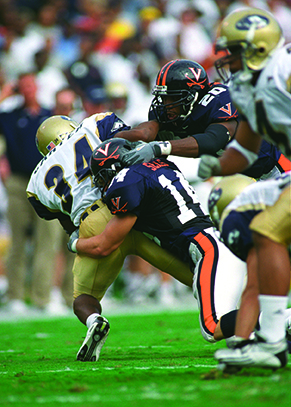
There has been an increase in awareness about brain trauma in recent years, especially in regard to football-related concussions and combat-acquired traumatic brain injuries (TBIs). UVA Health System has been on the forefront of advancing this cause, establishing the Brain Injury and Sports Concussion (BISC) Institute in 2002 and the BISC Clinic in 2014. The mission: to drive TBI research; provide education and outreach; and advance comprehensive, specialized care for patients.
James R. Stone, MD, PhD, co-directs the institute and oversees its research arm. An associate professor of radiology and medical imaging as well as neurological surgery, Stone notes that the institute’s research has broad-reaching implications — not just for patients at the BISC Clinic, but also for how TBI is managed as a disease entity.
“It is the sort of research that is laying the groundwork and forging new paths for the entire field so that we have better tools to manage this condition,” Stone says.
Viewing Brain Injury on a Molecular Level
Injury-related changes in the brain often occur on a cellular and molecular level, according to Stone. UVA BISC Institute is developing and applying molecular imaging approaches to identify what is occurring in the brains of TBI patients, which can in turn guide therapeutic interventions.
One area of this molecular-level research involves studying markers of inflammation in injured brains in a translational setting through experimental modeling, using probes that have already undergone safety testing in humans. The goal is to use imaging to observe how immune cells respond in someone with TBI, thereby diagnosing the specific injury and tailoring a course of treatment.
Another research effort involves scanning the brain for evidence of normal resident enzymes acting out of control due to disruption in that area of the brain. The enzymes digest proteins within brain cells — activity that can be visualized with advanced imaging tools. “By honing in on these molecular and cellular events, we can get a window into the things that are occurring within the brains of traumatized individuals that we would have no other means of identifying in a living person,” Stone says.
Mapping the Brain
A third major area of research at UVA BISC Institute involves transitioning advanced magnetic resonance imaging (MRI) into the clinical setting for the diagnosis of TBI. Presently, several very promising MRI approaches exist for the detection of microscopic injury that is known to occur after TBI. However, to date, the foundational work required to map the variation of normal across the population with these tools has not been performed. Without that foundation of knowledge, these tools remain limited to research applications.
Over the next three years, UVA BISC Institute will work with the American College of Radiology and Army Office of the Surgeon General — along with Baylor College of Medicine, Walter Reed Army Medical Center, San Antonio Military Medical Center and National Intrepid Center of Excellence at Fort Campbell — to utilize brain MRIs of more than 3,000 people to create the composite “normal” view of the brain. Similar to the process of mapping the human genome and its various mutations, a resulting normal map of the brain will provide a comparison for physicians assessing brains that have sustained some level of injury. This brain map will be integrated with ongoing large-scale neuroimaging clinical research to develop a user-friendly platform that can be utilized in a clinical setting for the diagnosis of TBI.
These research efforts aim to improve clinicians’ ability to diagnose and treat TBI, says neuropsychologist Donna Broshek, PhD, co-director of both UVA BISC Institute and UVA Neurocognitive Assessment Lab. “We really want to get a handle on how to optimally manage concussions and brain injury,” she says. “There are a vast number of symptoms that can really be problematic afterwards and we want to make sure that we are efficient in identifying the factors that can prolong recovery, and then offer targeted care for those symptoms.”
Preventing Concussions in Athletes
In another UVA BISC Institute research program, neuroradiologist Jason Druzgal, MD, PhD, is overseeing a study he hopes could lead to tools for avoiding TBI among athletes in the first place. For his research, Druzgal enlisted the help of UVA college athletes in football, soccer and lacrosse who wore adhesive mastoid patch accelerometers that measured the force, direction and frequency of head impacts during practice and games. The athletes also underwent MRIs before and after the season to measure the changes these forces had on their brains. This data was assessed to gain a better understanding of the cumulative effects of subconcussive forces on the human brain. The researchers are now working to see what correlation may exist between the data gleaned from MRI and the sensors.
One goal of the research is to develop metrics that could provide an objective measurement — not unlike pitch counts in baseball — indicating when a player could be in danger of long-lasting effects from cumulative concussive and subconcussive impacts.
“If we develop the sensor technology in a way where it becomes more robust, we would be helping people before they’re considered patients, rather than once they become patients,” Druzgal explains. “I think that’s one place that we could make a difference.”
Learn more about UVA Brain Injury and Sports Concussion Clinic, the clinical arm of UVA BISC Institute, where patients of all ages are seen by a team that includes neuropsychologists, neurologists and physical medicine and rehabilitation specialists. To refer a patient to the clinic, call 434.98BRAIN (434.982.7246).